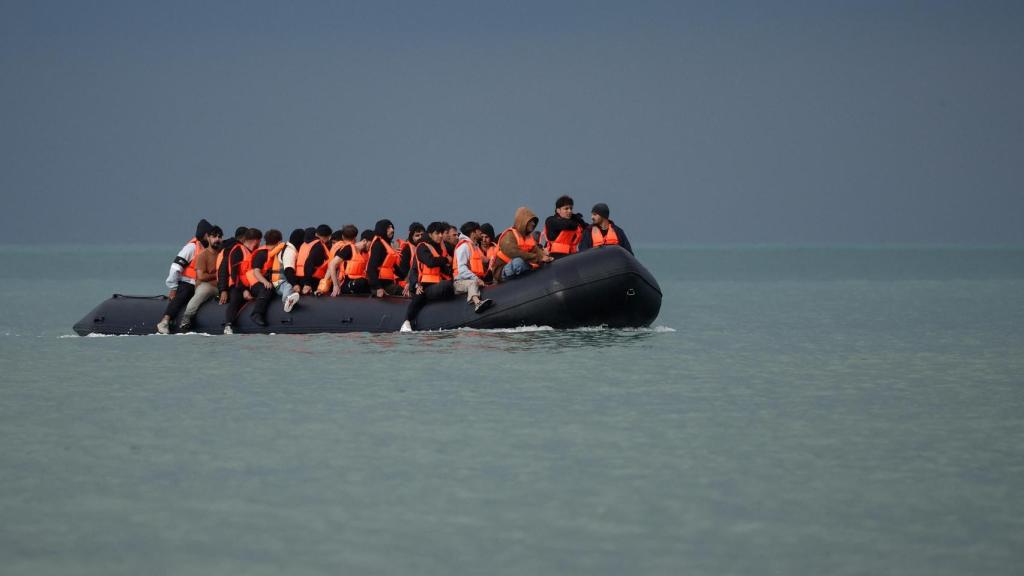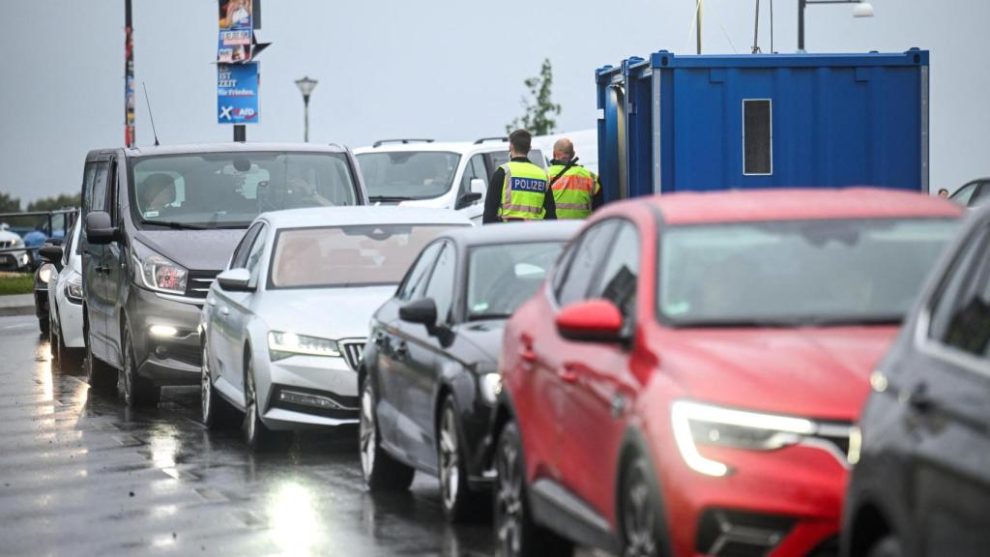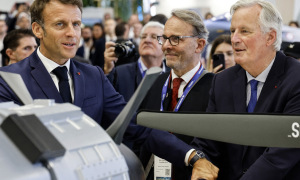He bad boy of the club. The most awkward member of the family. The Hungarian Prime Minister, Viktor Orbánhas for years been the most belligerent leader in the management of migration flows in the European Union. In 2015, in the midst of the refugee crisis, raised 175 kilometers of fence It then re-established a wire fence on its southern border with Serbia. It then replicated the barrier on the border with Croatia and ended up temporarily re-establishing border controls with Slovenia, with which it shares a the Schengen area. All to stop the arrival of migrants who crossed from this country to go, above all, to Germany, which under the leadership of the Christian Democratic leader Angela Merkel had adopted an open arms policyParadoxically, it is this very Germany that has closed its doors today, reviving the fear that one of the main pillars of the European project is collapsing: the free movement of people and goods.
On September 9, the tripartite government of Olaf Scholz (which brings together social democrats, greens and liberals) announced the decision to impose temporary controls on all its borders –and to do so, moreover, within a week– to reduce irregular migration and protect the country from Islamist terrorism. “We are strengthening our internal security,” said Interior Minister Nancy Faeser. Specifically, the 3,767 kilometers that he shares with his neighbors, who were quick to respond. “It’s a suspension de facto “the Schengen agreement on a large scale,” denounced Polish Prime Minister Donald Tusk. For its part, Austria warned that it would not accept any migrant who was rejected at the German border. The decision, however, has shaken to the entire continent.
As explained Alberto Buenoprofessor of Political Science at the University of Granada and the University ofand Leipzig, a country with the weight of Germany imposes checks on its nine borders “sets a dangerous precedent”. Not because it is an exceptional measure, but “because it can have a knock-on effect.” In reality, the Schengen Agreementwhich came into force in 1995 and now extends to 29 States, gives its members the ability to temporarily introduce internal border controls in exceptional situations, such as in case of serious threat for public order or national security. However, in recent years, many countries have frequently resorted to this measure, on paper, “as a last resort”.
In total, eight countries currently have temporary border controls in place, according to data from the European Commission. Francefor example, has imposed them since the Paris attacks in 2015. As the limit is six months, which can be extended, the French president, Emmanuel Macron, has been extending them for various reasons. The last one? The increased risk of terrorist attacks during the Olympic and Paralympic Games.
In the case of Denmark, The surveillance of its border with Germany is due to fear of Russian espionage in the context of the invasion of Ukraine and terrorist threats related to the war in Gaza. Especially after anti-Islamic protests and the burning of the Koran by some extremist groups put the Scandinavian country in the crosshairs of militias. Something similar is alleged Sweden.
Even Germany has had controls at its borders for more than a year: in October 2023, coinciding with the outbreak of the war in the Middle East and an explosion in the arrival of people by balkan routeBerlin stopped free movement with Poland, the Czech Republic and Switzerland to curb illegal migration. According to the German government, this has allowed them to stop the entry of migrants. 30,000 migrants in this time.
It is precisely with this supposed “effectiveness” that the German Executive has excused itself for reinforcing the remaining borders – France, Luxembourg, the Netherlands, Belgium and Denmark – despite the fact that there is a risk that the flows of goods and workers who move freely between countries in the Schengen area. In fact, from the start there were warnings that there could be traffic jams and delays in railway movements. A priorithe measure will be in force until next year.
Vehicles pass through a checkpoint at the German-Polish border crossing “Stadtbruecke” in Frankfurt.
Elections in Brandenburg… and in 2025
“What is really exceptional in the case of Germany is that the decision was taken so immediately and that it was also a social democratic government, [tradicionalmente más laxos en política migratoria] “Whoever did it,” Bueno told El ESPAÑOL. The expert recalls how the announcement came shortly after the jihadist attack during a concert at a festival in the city of Solingen, in the west of the country, which left three dead. After the attack, criticism against the authorities for their management of immigration increased, and the German chancellor announced the deportation of 28 Afghans convicts for the first time since the Taliban arrived in the Central Asian country.
This discontent was later reflected in the polls with the historic rise of the far-right party, Alternative for Germany (AFD), which with an anti-immigration and xenophobic discourse came first in the regional elections in Thuringia and second in Saxony. “Scholz is trying to respond to the concerns about immigration that are being stirred up by the extreme right and which Conservatives are also putting pressure on “The Christian Democrats (CDU),” the academic says. He adds: “The movement has a completely electoral explanation.”
“The reintroduction of all borders in Germany sets a dangerous precedent”
It refers to the elections that are held This Sunday, September 22, in Brandenburgan eastern German state that has been a bastion of social democracy for decades and where the far-right is now emerging as the winner for the first time, according to polls.
For Moses Ruizprofessor of political leadership at the European University, the German chancellor’s immigration turn is also hampered by “the rise of the extreme right, which makes immigration its banner, and the pressures of the conservative right.” In his opinion, there is a fear that “your political choice follows the path to irrelevance”especially after the debacle of the European elections, where Scholz’s Social Democratic Party (PSD) was largely outnumbered by the conservatives.
“In view of the 2025 general elections, they are trying to show empathy to their traditional voters by being more belligerent against immigration because they know that there is a sociological shift in the working class on the issue of immigration,” he suggests. The clearest example of this change is in the Sahra Wagenknecht’s wife (Sahra Wagenknecht Alliance, BSW), the young German party founded by a former left-wing MP of Die Linke, which has a marked anti-immigration stance. “It has been able to channel this discontent,” concludes Ruiz.
Europe buys the ultra speech
It is, however, a widespread trend: both the traditional right and European Social Democracy They are buying into the far-right thesis on migration. At least in words.
Just a few weeks ago, British Prime Minister Keir Starmer, Labour, applauded the “remarkable progress” on migration from his Italian counterpart, Giorgia Meloni, the leading representative of the radical right in the EU. In particular, he said he was interested in the controversial and dubious legality project to open in Albaniaa non-EU country, two centres to house migrants rescued in Italian waters.

Migrants in an inflatable boat attempt to cross the English Channel to reach Britain, at Slack Dunes beach in Wimereux, France, in September 2024.
Days later, the leader of the Spanish Popular Party, Alberto Núñez Feijóo, praised the Italian model, which includes agreements with Libya and Tunisia to close the passage to migrants. A system that has allowed Rome to reduce 60% the number of arrivals of illegal migrants across the Mediterranean. Previously, in the summer, in the midst of an increase in migratory pressure in Ceuta and the Canary Islands, the president of the Spanish Government, Pedro Sanchezhardened his speech. In a slight twist of the script, the socialist described “essential” the return to their countries of those who arrive in Spain irregularly and advocated “orderly migration.”
Symbolic measures?
“The electorate has changed and now they count for much more Identity aspects that social issues; that is why the left has a problem, because it cannot get a positive or alternative discourse in terms of immigration to penetrate that of the right without this being electorally detrimental,” he explains. Francesco Pasettiprincipal researcher in the Migration area of CIDOB and adjunct professor at the Institut Barcelona d’Estudis Internacionals (IBEI).
“In a moment of Extreme politicization of the migration issue and in the face of an increase in far-right parties, more restrictive policies are inevitably applied, but they are more symbolic “How effective in stopping immigration,” he argues. The expert is mainly referring to the imposition of temporary border controls. And even though the flows are reduced in the short term, in the long term, refugees They usually change their route and take other, more dangerous routes to reach Europe, according to research by the UN Refugee Agency (UNHCR).
“Worrying about the threat from outside is causing us to collapse from within”
Likewise, for the researcher, these policies “try to respond quickly to the fear created by the discursive climate” has serious humanitarian consequences“Studies tell us that when these border measures are implemented on an emergency basis, the international protection protocols that should guarantee the rights of people seeking asylum are undermined,” he explains.
However, he recalls, they also impact on the waterline of the European project: “By worrying about the threat coming from outside, we are collapsing from within. States are entrenched in their national interests and Europe is moving away from unity and solidarity.”
“The immigration issue can only be solved at European level,” says Pasetti. The problem is that since the refugee crisis of 2015, the EU has been unable to bring order to the chaos of EU migration policy. At least until last year. Then a final agreement was reached on the European Pact on Migration and Asylum based on the reinforcement of external borders and the tightening of asylum conditions. However, this will not be fully implemented until June 2026.
So we will have to wait and see if the reform can take off before becoming obsolete or if, on the contrary, we will soon see Orbán repeating with other countries the words he addressed to the Germans after the reintroduction of controls: “I told you so. Welcome to the club.”.















Add Comment